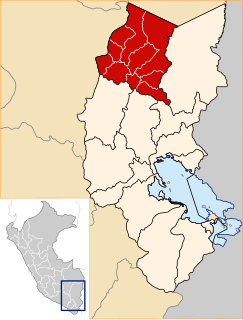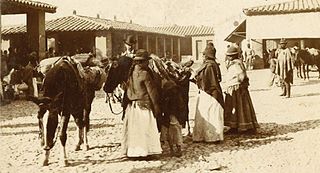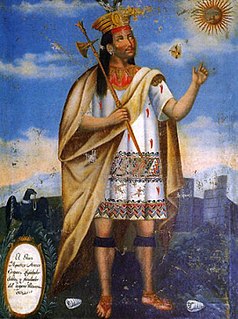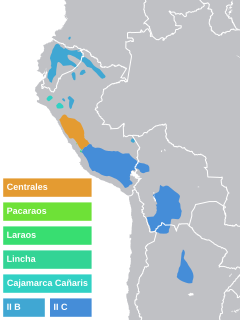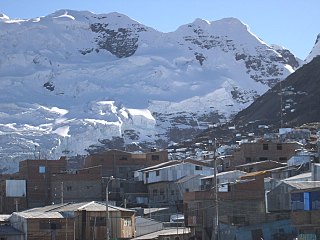Puno Region | |||
|---|---|---|---|
 Lake Titicaca, which is partly located in the Puno Region | |||
| |||
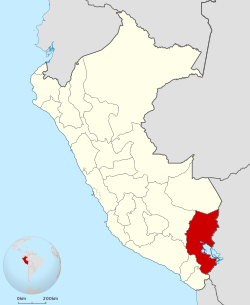 Location of the Puno Region in Peru | |||
| Coordinates: 15°04′S70°07′W / 15.07°S 70.12°W Coordinates: 15°04′S70°07′W / 15.07°S 70.12°W | |||
| Country | Peru | ||
| Subdivisions | 13 provinces and 108 districts | ||
| Capital | Puno (138000) | ||
| Government | |||
| • Governor | Walter Aduviri Calisaya (2019–2022) | ||
| Area | |||
| • Total | 66,997 km2 (25,868 sq mi) | ||
| Population (2017) | |||
| • Total | 1,172,697 | ||
| • Density | 18/km2 (45/sq mi) | ||
| UBIGEO | 21 | ||
| Dialing code | 0+51 | ||
| ISO 3166 code | PE-PUN | ||
| Principal resources | Quinoa; it is also the nation's largest producer of potatoes, sheep, alpacas and llamas. | ||
| Poverty rate | 60.8% (INEI 2009) | ||
| Percentage of Peru's GDP | 2.3% | ||
| Website | www.regionpuno.gob.pe | ||
Puno (Spanish pronunciation: [ˈpuno] ) is a region in southeastern Peru. It is bordered by Bolivia on the east, the regions of Madre de Dios on the north, Cusco and Arequipa on the west, Moquegua on the southwest, and Tacna on the south. Its capital is the city of Puno, which is located on Lake Titicaca in the geographical region known as the Altiplano or high sierra.

The regions of Peru are the first-level administrative subdivisions of Peru. Since its 1821 independence, Peru had been divided into departments but faced the problem of an increasing centralization of political and economic power in its capital, Lima. After several unsuccessful decentralization attempts, the legal figure of region became official and regional governments were elected to manage the departments on November 20, 2002, until their planned fusion into real regions.

Peru, officially the Republic of Peru, is a country in western South America. It is bordered in the north by Ecuador and Colombia, in the east by Brazil, in the southeast by Bolivia, in the south by Chile, and in the west by the Pacific Ocean. Peru is a megadiverse country with habitats ranging from the arid plains of the Pacific coastal region in the west to the peaks of the Andes mountains vertically extending from the north to the southeast of the country to the tropical Amazon Basin rainforest in the east with the Amazon river.

Bolivia, officially the Plurinational State of Bolivia is a landlocked country located in western-central South America. The capital is Sucre while the seat of government and financial center is located in La Paz. The largest city and principal industrial center is Santa Cruz de la Sierra, located on the Llanos Orientales a mostly flat region in the east of Bolivia.
Contents
Puno was the territory of the Tiahuanacos (800 A.D. – 1200 A.D.), who were the highest cultural expression of the Aymara people who established themselves in what is today Peru and Bolivia. The Incas took over these lands in the fifteenth century, and the Spanish, attracted by the mining industry developed there, left an important Colonial legacy throughout the entire area.

The Tiwanaku state was a Pre-Columbian polity in western Bolivia based in the southern Lake Titicaca Basin. Tiwanaku was one of the most significant Andean civilizations. Its influence extended into present-day Peru and Chile and lasted from around AD 550 to 1000. Its capital was the monumental city of Tiwanaku, located at the center of the state's core area in the southern Lake Titicaca Basin. This area has clear evidence for large-scale agricultural production on raised fields that probably supported the urban population of the capital. Researchers debate whether these fields were administered by a bureaucratic state (top-down) or through collaboration of a segmented state or federation with local autonomy. One obsolete theory suggests that Tiwanaku was an expansive military empire, based on comparisons to the later Inca Empire, but supporting evidence is weak.






